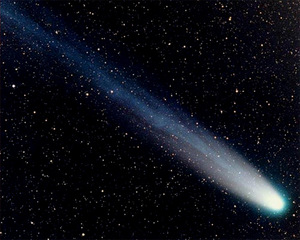
|
| ©NASA
|
| Bacteria, known to be capable of thriving in extremely harsh environments, could have traveled through space on comets. If even one microbe survived space travel to Earth, it would be enough to start a colony on our planet.
|
Fans of extraterrestrial life may have been disappointed when internet-fed rumors of Martian life ended in a
NASA press conference on soil composition.
But they can take solace in a newly popular theory that suggests the rest of space may teem with microbes.
This once-controversial notion holds that the universe is filled with the ingredients of microbial life, and that earthly life first came from the skies as comet dust or meteorites salted with hardy bacteria.
"Studies have shown that microbes can survive the shock levels of being launched into space," said Charles Cockell, a microbiologist at the Open University. "And as more and more organisms are discovered under extreme conditions, it's become more plausible that things could survive in space for the time it takes to go from one planet to another."
Not long ago, Cockell's claims would have been greeted with scientific derision. But as scientists learn more about Earth and space, the theory, which goes by the grandiose name of "galactic panspermia," seems less far-fetched.
Bacteria, recent discoveries have shown, thrive in Earth's most extreme locales, from Antarctic ice to the interiors of volcanoes and nuclear reactors, and have even survived in space. Meanwhile, astronomers seem to find Earth-like planets wherever they train their telescopes; comets have proven unexpectedly rich in organic material. Closer to home, water was once
widespread on Mars, and still suffuses the atmosphere of Venus.
Perhaps life could evolve in a comet, or survive inside a rock catapulted into orbit by a planetary meteor strike. The odds might be against it -- but life is good at beating the odds.
"One hundred years ago, people wondered if animals could go from one land mass to another," said Cockell. But then people discovered that birds migrate for thousands of miles, that storms carry insects across oceans and seeds between continents. "Panspermia is the next step," he said.
Galactic panspermia advocates aren't exactly saying that little green men came to Earth and planted the seeds of life here. At the simplest end of the spectrum is the proposition that earthly life was jump-started by the arrival of its basic components from space. Meteors have proven rich in amino acids -- the building blocks of life -- and Earth was pummeled by meteors for the first 200 million years of its existence. In April, Columbia University chemist Ronald Breslow traced the molecular signatures of earthly amino acids to those of neutron stars.
"Everything that is going on on Earth occurred because the meteorites happened to land here. But they are obviously landing in other places," he said at the time. "If there is another planet that has the water and all of the things that are needed for life, you should be able to get the same process rolling."
But Earth -- and planets in general -- might not be the only habitable space locales. Comets -- orbiting collections of ice, dust and rocks -- are rich in nitrogen and oxygen, as well as other organic material.
Chandra Wickramasinghe, a Cardiff University astronomer and astrobiology pioneer, suggests that heat from radioactive elements could melt the normally frozen water inside comets, making them a perfect interstellar petri dish. Microbial life could evolve inside them, or simply be picked up from a passing meteor originally ejected into space from a life-rich planet.
Is that likely? In any given comet, perhaps not. But there are billions of comets in our solar system alone, floating like so many dandelion seeds through the ether, and bacteria have proven freakishly durable. They've been recovered from Antarctic ice and revived after 10 million years in deep-freeze. Some Black Sea strains photosynthesize in near-darkness, while others thrive on nuclear radiation or infrared light. Bacteria have been found inside volcanoes and in sediments miles
beneath the ocean floor.
Bacteria have even survived exposure to the vacuum of space, as well as pressures comparable to those generated by meteor strikes capable of kicking debris out of Earth's orbit. And all that's necessary to establish a new bacteria colony, Wickramasinghe calculated, is for one microbe in 1,000,000,000,000,000,000,000 to flourish in its new environs.
Wickramasinghe even concluded that organic material found in comets -- most recently by the Stardust spacecraft, which plucked amino acids from the 81P/Wild 2 comet -- is biological in origin. In other words, the comet is not just a good place for life to grow, but actually contains organic material produced by earlier life, Wickramasinghe believes.
That is, of course, hypothetical, and not everyone is convinced. "Some astrobiologists are evangelists," said Columbia University biometeorologist Nancy Kiang. But with further bacteria-in-space experiments planned by NASA and the European Space Agency, and missions ongoing to sample other planets and interstellar bodies, the evangelists are being taken seriously.
"The universe is mostly empty space, but here and there are special places where complex things can happen: clouds of dust, planetary surfaces, comets and asteroids," said Cornell University astrogeologist Jim Bell. "They appear scattered throughout most of the observable space we can study with our instruments thus far. Astronomers have been finding hundreds of planets around other stars. There are probably lots more places out there where life could exist."
Reader Comments
to our Newsletter